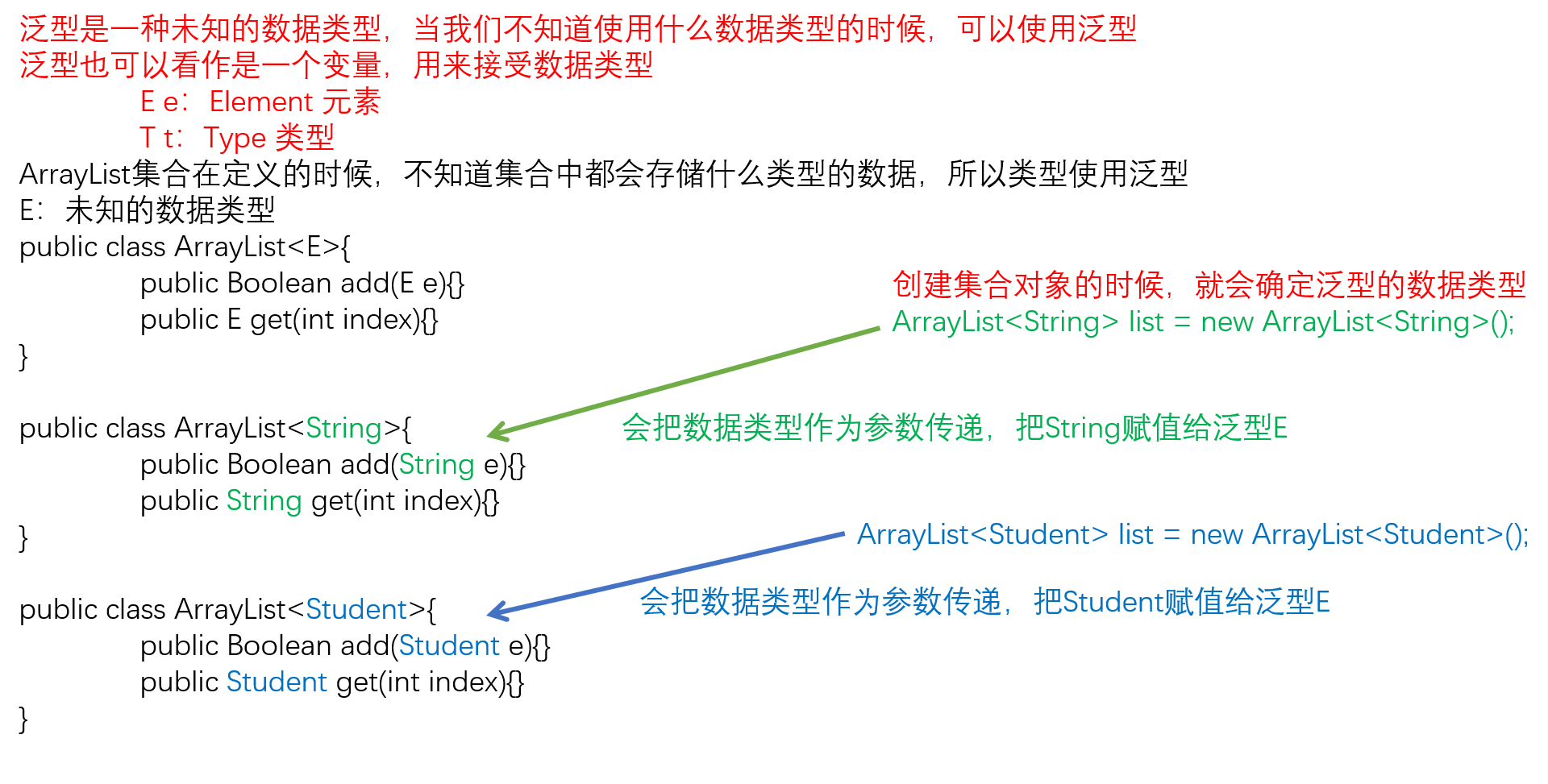Java的泛型
泛型
泛型概念

使用泛型及不使用泛型的优缺点
import java.util.ArrayList;
import java.util.Iterator;
public class Demo01Generic {
public static void main(String[] args) {
show01();
show02();
}
/*
创建集合对象,使用泛型
好处:
1.避免了类型转换的麻烦,存储的是什么类型,取出的就是什么类型
2.把运行期异常(代码运行之后会抛出的异常),提升到了编译期(写代码的时候会报错)
弊端:
泛型是什么类型,之恩那个存储什么类型的数据
*/
private static void show02() {
ArrayList<String> list = new ArrayList<>();
list.add("abc");
//list.add(1);//add(java.lang.String)in ArrayList cannot be applied to (int)
//使用迭代器遍历list集合
Iterator<String> it = list.iterator();
while (it.hasNext()){
String s = it.next();
System.out.println(s+"->"+s.length());
}
}
/*
创建集合对象,不使用泛型
好处:
集合不使用泛型,默认的类型就是Object类型,可以存储任意类型的数据
弊端:
不安全,会引发异常
*/
private static void show01() {
ArrayList list = new ArrayList();
list.add("abc");
list.add(1);
//使用迭代器遍历list集合
//获取迭代器
Iterator it = list.iterator();
//使用迭代器中的方法hasNext和next遍历集合
while(it.hasNext()){
//取出元素也是Object类型
Object obj = it.next();
System.out.println(obj);
//想要使用String类特有的方法,length获取字符串长度,不能使用 多态 Object obj = "abc";
//需要向下转型
//会抛出ClassCastException类型转换异常,不能把Integer类型转换为String类型
String s = (String) obj;
System.out.println(s.length());
}
}
}
定义和使用含有泛型的类
/*
定义一个含有泛型的类,模拟ArrayList集合
泛型是一个未知的数据类型,当我们不确定什么数据类型的时候,可以使用泛型
泛型可以接收任意的数据类型,可以使用Integer,String,Student...
创建对象的时候确定泛型的数据类型
*/
/*
public class Generic {
private String name;
public String getName() {
return name;
}
public void setName(String name) {
this.name = name;
}
}
*/
public class Generic<E> {
private E name;
public E getName() {
return name;
}
public void setName(E name) {
this.name = name;
}
}
===========================================================
public class Demo02GenericClass {
public static void main(String[] args) {
//不写泛型默认为Object类型
Generic gc = new Generic<>();
gc.setName("只能是字符串");
Object obj = gc.getName();
//创建Generic对象,泛型使用Integer类型
Generic<Integer> gc2 = new Generic<>();
gc2.setName(1);
Integer name = gc2.getName();
System.out.println(name);
//创建Generic对象,泛型使用String类型
Generic<String> gc3 = new Generic<>();
gc3.setName("小明");
String name1 = gc3.getName();
System.out.println(name1);
}
}
定义和使用含有泛型的方法
/*
定义含有泛型的方法:泛型定义在方法的修饰符和返回值类型之间
格式:
修饰符 <泛型> 返回值类型 方法名(参数列表(使用泛型)){
方法体;
}
含有泛型的方法,在调用方法的时候确定泛型的数据类型
传递什么类型的参数,泛型就是什么类型
*/
public class GenericMethod {
//定义一个含有泛型的方法
public <M> void method01(M m){
System.out.println(m);
}
//定义一个含有泛型的静态方法
public static <S> void method02(S s){
System.out.println(s);
}
}
==============================================================
/*
测试含有泛型的方法
*/
public class Demo03GenericMethod {
public static void main(String[] args) {
//创建GenericMethod对象
GenericMethod gm = new GenericMethod();
/*
调用含有泛型的方法method01
传递什么类型,泛型就是什么类型
*/
gm.method01(10);
gm.method01("abc");
gm.method01(8.8);
gm.method01(true);
gm.method02("静态方法,不建议创建对象使用");
//静态方法,通过类名.方法名(参数)可以直接使用
GenericMethod.method02("静态方法");
GenericMethod.method02(1);
}
}
定义和使用含有泛型的接口
/*
定义含有泛型的接口
*/
public interface GenericInterface<I> {
public abstract void method(I i);
}
===========================================================================
/*
含有泛型的接口,第一种使用方式:定义接口的实现类,实现接口,指定接口的泛型
public interface Iterator<E> {
E next();
}
Scanner类实现了Iterator接口,并指定接口的泛型为String,所以重写的next方法泛型默认就是String
public final class Scanner implements Iterator<String>{
public String next() {}
}
*/
public class GenericInterfaceImpl1 implements GenericInterface<String>{
@Override
public void method(String s) {
System.out.println(s);
}
}
============================================================================
/*
含有泛型的接口第二种使用方式:接口使用什么泛型,实现类就使用什么泛型,类跟着接口走
就相当于定义了一个含有泛型的类,创建对象的时候确定泛型的类型
public interface list<E>{
boolean add(E e);
E get(int index);
}
public class ArrayList<E> implements list<E>{
public boolean add(E e) {}
public E get(int index) {}
}
*/
public class GenericInterfaceImpl2<I> implements GenericInterface<I>{
@Override
public void method(I i) {
System.out.println(i);
}
}
=============================================================================
/*
测试含有泛型的接口
*/
public class Demo04GenericInterface {
public static void main(String[] args) {
//创建GenericInterfaceImpl1对象
GenericInterfaceImpl1 gi1 = new GenericInterfaceImpl1();
gi1.method("字符串");
//创建GenericInterfaceImpl2对象
GenericInterfaceImpl2<Integer> gi2 = new GenericInterfaceImpl2<>();
gi2.method(10);
GenericInterfaceImpl2<Double> gi3 = new GenericInterfaceImpl2<>();
gi3.method(8.8);
}
}
泛型通配符
import java.util.ArrayList;
import java.util.Iterator;
/*
泛型的通配符:
?:代表任意的数据类型
使用方式:
不能创建对象使用
只能作为方法的参数使用
*/
public class Demo05Generic {
public static void main(String[] args) {
ArrayList<Integer> list01 = new ArrayList<>();
list01.add(1);
list01.add(2);
ArrayList<String> list02 = new ArrayList<>();
list02.add("a");
list02.add("b");
printArray(list01);
printArray(list02);
//ArrayList<?> list03 = new ArrayList<?>();//编译报错,定义时不能使用?
}
/*
定义一个方法,能遍历所有类型的ArrayList集合
这时候我们不知道ArrayList集合使用什么数据类型,可以使用泛型的通配符?来接收数据类型
注意:
泛型没有继承概念
*/
public static void printArray(ArrayList<?> list){
//使用迭代器遍历集合
Iterator<?> it = list.iterator();
while (it.hasNext()){
//it.next()方法,取出的元素是Object,可以接收任意的数据类型
Object o = it.next();
System.out.println(o);
}
}
}
===========================================================================
import java.util.ArrayList;
import java.util.Collection;
/*
泛型的上限限定:? extends E 代表使用的泛型只能是E类型的子类/本身
泛型的下限限定:? super E 代表使用的泛型只能是E类型的父类/本身
*/
public class Demo06Generic {
public static void main(String[] args) {
Collection<Integer> list1 = new ArrayList<Integer>();
Collection<String> list2 = new ArrayList<String>();
Collection<Number> list3 = new ArrayList<Number>();
Collection<Object> list4 = new ArrayList<Object>();
getElement1(list1);
getElement1(list2);//报错
getElement1(list3);
getElement1(list4);//报错
getElement2(list1);//报错
getElement2(list2);//报错
getElement2(list3);
getElement2(list4);
/*
类与类之间的继承关系
Integer extends Number extends Object
String extends Object
*/
}
//泛型的上限:此时的泛型?,必须是Number类型或者Number类型的子类
public static void getElement1(Collection<? extends Number> coll){}
//泛型的下限:此时的泛型?,必须是Number类型或者Number类型的父类
public static void getElement2(Collection<? super Number> coll){}
}
作者:wangyudong
本文版权归作者和博客园共有,欢迎转载,但必须给出原文链接,并保留此段声明,否则保留追究法律责任的权利。





